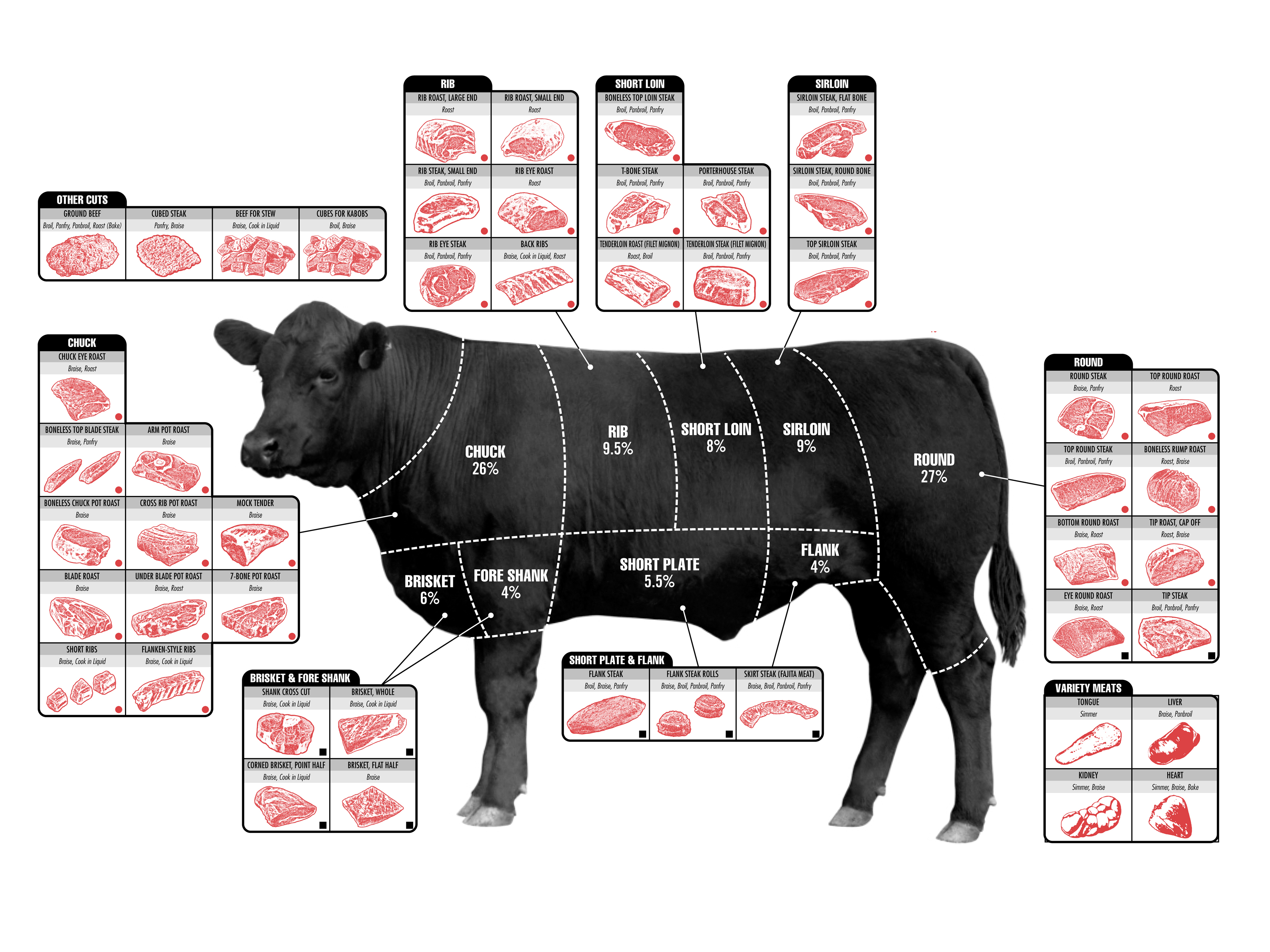BRISKET vs CORNED BEEF :: They are both from the front chest area of the cow near the bottom of the chest, but they are not the same thing.
Fresh beef brisket is like a big roast. It refers to a cut of meat. The FLAT CUT is larger and leaner, which calls for a quick preparation. The POINT CUT is fattier and has more flavor. You should braise the point cut to allow for the breakdown of connective tissue. Trim some fat from each before preparing.
Corned beef frequently starts out as beef brisket and is brine-cured first. Corned beef refers to the curing/seasoning method, not the cut of meat.
Not all corned beef is brisket and certainly not all brisket is corned beef. Corned beef is usually cooked in a crock pot or dutch oven and the result is rather pink
Brisket Recipes
- Stovetop Brisket
- This is a good recipe for those without an oven
- Beer Braised Brisket
- This creates a more tender brisket than the stoveop method, but takes three times longer
- Tomato Brisket
- This is a good oven brisket that is easy and heavy on the tomato
- Instant Pot Brisket
- A good recipe from Amy and Jackie
Corned Beef
- Traditional Corned Beef Recipe
- Making Corned Beef from Scratch
What’s the difference between…
Pastrami vs. corned beef
The deli counter is full of pressing questions — because while you may have some vague understanding that pastrami and corned beef are two different things, and that one might be better than the other, you may be stuck on the how or why. Here are the major points of differentiation between the two, because no meat should ever be a mystery.
Pastrami and corned beef have different countries of origin: Pastrami has two possible ancestries: It’s either Romanian (where its predecessor, pastrama, was made with pork or mutton) or Turkish (where it’d be a descendent of pastirma, made with beef). Corned beef hails from Ireland, which is why it’s eaten on St. Patrick’s Day.
Pastrami and corned beef are different cuts of meat: Today’s corned beef and pastrami are both made from beef, albeit different parts of the animal. Corned beef is made from brisket, which comes from the lower chest of the cow; pastrami is either made from a cut called the deckle, a lean, wide, firm shoulder cut, or the navel, a smaller and juicier section right below the ribs. These days, you may also see pastrami made from brisket.
Pastrami and corned beef do have the same brine: Pastrami and corned beef are brined before they’re cooked; they’re either rubbed with or submerged in a solution of salt and spices to infuse the meat with more moisture and flavor. Both are brined in a mixture of salt, sugar, black pepper, cloves, coriander, bay leaves, juniper berries, and dill, as well as the preservatives sodium nitrate or sodium nitrite.
Pastrami and corned beef have different spice mixes: Here’s when things really start to differ. After brining, pastrami gets coated in a mixture of black pepper, coriander, mustard seeds, fennel seeds, and sometimes fresh garlic; that spice coating is what gives it its blackened appearance. Corned beef is… naked. No spice mix to speak of.
Pastrami and corned beef have different cooking methods: Pastrami is smoked over hardwood, oftentimes with a pan of water nearby, which helps create steam and keep the meat moist. It’s then cooled and then steamed before serving. Corned beef is… boiled. Sometimes with cabbage and other accoutrements in the mix, too.
Bonus round: If you’ve ever been to Montreal, you may be wondering: What does “smoked meat” have to do with all this? Smoked meat is a Canadian specialty that pulls from the same themes as corned beef and pastrami, but has a story arc of its own. It’s made with brisket and is brined in a mixture of black pepper, coriander, garlic, and mustard seeds — but with much less sugar than its pastrami and corned-beef cousins. It’s then smoked, like pastrami, and is best layered onto rye bread with mustard for serving — just like the rest of family.

